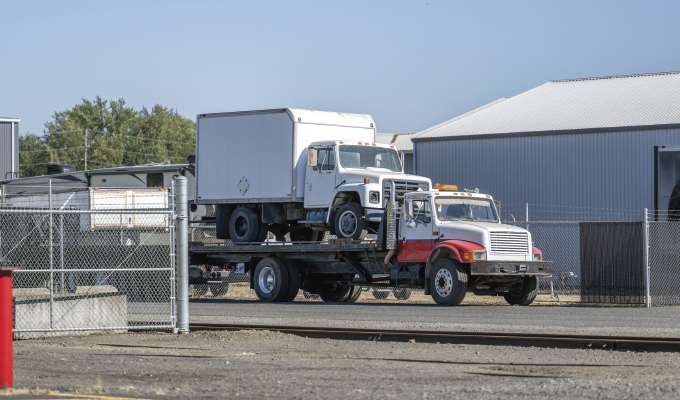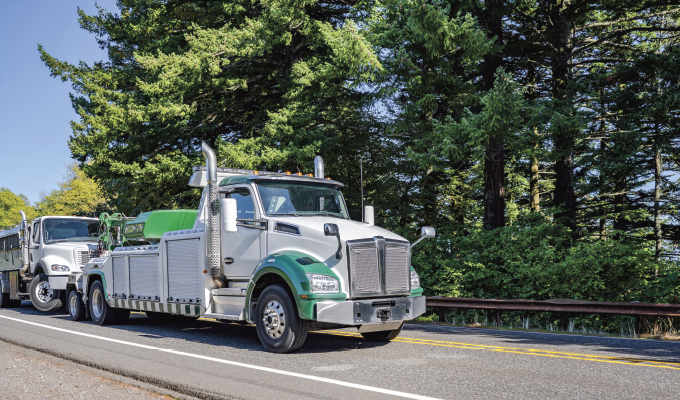Business depends on keeping work trucks, vans, and utility vehicles on the road—all day, every day. Unfortunately, all those extra miles mean those vehicles are four times more likely to have a disablement event than a typical passenger vehicle. While these events fall into several different job classes and service types, heavy-duty tows are typically complicated, and a substantial percentage involve servicing commercial vehicles. In these cases, time is money, and a speedy resolution is even more crucial to minimize business downtime.
On the surface, heavy-duty tows appear similar to those for passenger or light-duty vehicles; the reality is that heavy-duty tows present a significantly higher degree of uncertainty, difficulty, and complexity. As a result, these tows require a tailored approach during the inevitable roadside event. Here’s what fleet operators can know and do to streamline the process.
SPECIALIZED EQUIPMENT
It takes a special kind of tow truck—what we commonly refer to as a “wrecker”—to recover vehicles that surpass the average vehicle weight or height. Heavy-duty wreckers must be prepared to recover and haul an overturned semi-trailer or pull an overturned dump truck from a ditch. This requires a towing capacity of between 25 and 100 tons, which is much more than the standard three to five-ton tow capacity. In addition, heavy-duty recoveries can call for advanced functionality, such as outrigger legs to help with truck stability (to avoid flipping the wrecker itself) or increased boom lift capacity.
LIMITED SUPPLY
Recovering an overturned dump truck from a ditch is more challenging and time consuming than moving a compact sedan in a similar situation. These situations can often be more time sensitive as well: a package delivery van or perishable food shipment can’t be stuck on the road for hours. Because of the higher level of skill and training required to operate heavy-duty wreckers, they are in limited supply and account for a small percentage of the national towing provider mix. On average, there’s roughly one truck available to perform heavy-duty tows for every 10 that can handle light- and medium-duty tows. What’s more, these wreckers cost three to four times as much as a standard tow truck, requiring a substantial financial investment that often proves insurmountable for smaller towing companies.

CALCULATE WEIGHT
One thing that can help reduce the amount of time between an event and getting back on the road is proper vehicle identification. Work trucks are often altered after purchase. For example, the owner may buy a chassis and an engine but then make modifications to add a crane or box, which can add significant weight or introduce new variables when a tow is needed. If these modifications do add weight, it can put the vehicle into a higher class of tow compared to its base configuration, which can result in delays to secure the appropriate operators and wrecker equipment.
It’s important for drivers and fleet management companies to communicate these modifications during the initial call to the roadside assistance dispatcher so they can ensure the correct wrecker arrives to service the breakdown event. It’s also necessary to communicate if a truck is loaded with work equipment or packages, as the extra weight of these loads could change the class type of a vehicle from medium to heavy for towing purposes.
ROADSIDE PROGRAMS
Heavy-duty tow jobs are complex, and there are many variables to consider. For example, is the heavy-duty tow absolutely necessary, or could a mobile mechanic provide faster on-scene repairs, tire delivery and installation, or other more straightforward services? With this in mind, it’s important to optimize roadside coverage for quality service, nationwide coverage, efficient resolution, and job process transparency. Let’s delve into each in a bit more detail.
- Knowledge and Experience: With all the variables that can lead to delays in heavy-duty jobs, work truck fleets need a well-oiled roadside care machine optimized for high-quality customer service. This should include capabilities like ASE-certified technicians and customer care agents that understand the needs and requirements of work trucks and heavy-duty tow events. In addition, consider the importance of a dedicated case management team experienced in matching and optimizing the nine classes of heavy-duty vehicle types and five classes of heavy-duty wreckers to get you back on the road.
- Coverage: I’ve already touched on a number of factors contributing to the limited supply of heavy-duty wreckers. If the right truck isn’t available, then nothing else matters. While a roadside assistance program may claim to offer service to every zip code, ensure they also maintain a curated network of providers that not only has the wreckers to handle heavy-duty tows when and where you need them but also has deep expertise managing complex work truck fleets and heavy-duty roadside programs.
- Efficiency: There are several factors that impact a resolution. For example, a skilled roadside assistance dispatch agent should possess a combination of human knowledge (e.g., asking the right probing questions to ensure the correct vehicle is dispatched to the scene) and system knowledge (e.g., having the experience to understand different event types and what each means based on the type of vehicle) in order to successfully complete any job quickly and correctly.
- Transparency: While job speed is important, so is transparency into job updates. With so many inputs in a heavy-duty tow, delays can happen. When they do, you need to be able to track the extent of the delay and plan accordingly. The technology in this space is constantly evolving, but look for programs that offer SMS text messaging, in-app chat, or even digital portal access for real-time status updates.
From tonnage to height, there are many considerations that go into the decision-making behind a heavy-duty tow. Understanding the complexities that influence accurate dispatch and knowing what information to provide can help ensure timely resolution during an event. Because of the uniqueness of heavy-duty tows, look for a roadside assistance program that focuses on offering quality service, efficient resolution, transparency throughout the event life cycle, and a nationwide network of heavy-duty wreckers to ensure matching of the best trucks and equipment for each event.
ABOUT THE AUTHOR
Tim Young is a vice president for Agero’s Automotive Division, leading its fleet business and driving new business development. Find out more, visit www.agero.com.




